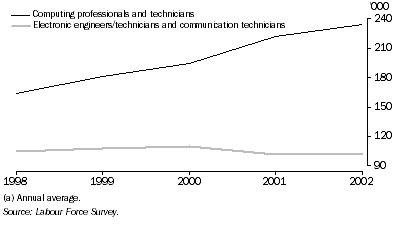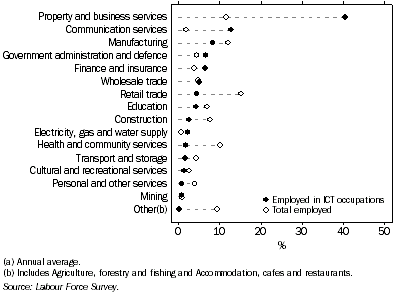Feature Article - Employment in information and communication technology
Introduction
The importance of ICT in enhancing long-term economic growth, increasing productivity and furthering technological development was acknowledged in the ABS discussion paper Measuring a Knowledge-based Economy and Society, An Australian Framework, 2002 (cat. no. 1375.0). This article uses data from the Labour Force Survey (LFS) to analyse various characteristics of persons employed in ICT occupations (also referred to as 'ICT workers') in Australia over the past five years.
Classification of ICT occupations
ABS collections use the Australian Standard Classification of Occupations (ASCO) Second Edition (cat. no. 1220.0) to classify occupations according to skill level and skill specialisation. LFS data on occupations are collected each February, May, August and November, and coded to the Unit Group (i.e. 4-digit) level of ASCO. For the purposes of this article, Unit Groups relating to ICT occupations have been grouped into two broader occupational groups: computing professionals and technicians; and electronic engineers/technicians and communication technicians.
Employment in ICT occupations
The total number of ICT workers has increased by 26% over the past five years, from 268,700 in 1998 to 337,500 in 2002. ICT workers comprised 3.6% of all employed persons in 2002, compared with 3.1% in 1998.
The following table shows, for 1998 to 2002, the number of persons employed in ICT occupations and the number of all employed persons. Data shown are annual averages.
EMPLOYED PERSONS, ICT occupation groups—total ICT workers and total employed—1998 to 2002(a) |
|  |
 |  | 1998 | 1999 | 2000 | 2001 | 2002 |  |
 |  | '000 | '000 | '000 | '000 | '000 |  |
|  |
| Computing professionals and technicians |  |  |  |  |  |  |
 | Information technology managers | 15.4 | 15.0 | 17.9 | 29.0 | 29.7 |  |
 | Computing professionals | 132.1 | 141.0 | 150.8 | 162.9 | 174.3 |  |
 | Computing support technicians | 16.8 | 24.6 | 25.9 | 30.0 | 30.8 |  |
 | Total | 164.3 | 180.7 | 194.6 | 221.9 | 234.8 |  |
| Electronic engineers/technicians and communication technicians |  |  |  |  |  |  |
 | Electrical and electronics engineers | 24.1 | 27.2 | 25.2 | 24.8 | 25.5 |  |
 | Electronic engineering associate professionals | 15.4 | 15.6 | 16.8 | 16.1 | 14.5 |  |
 | Electronic and office equipment tradespersons | 34.6 | 33.9 | 37.4 | 32.7 | 36.9 |  |
 | Communications tradespersons | 27.8 | 28.8 | 27.3 | 24.9 | 22.9 |  |
 | Electrical and telecommunications trades assistants | 2.4 | 2.3 | 3.2 | 2.7 | 2.8 |  |
 | Total | 104.4 | 107.9 | 109.8 | 101.1 | 102.7 |  |
| Total ICT workers | 268.7 | 288.5 | 304.4 | 323.0 | 337.5 |  |
| Total employed | 8,553.1 | 8,747.4 | 9,009.4 | 9,123.9 | 9,311.4 |  |
| Proportion of total employed that are ICT workers (%) | 3.1 | 3.3 | 3.4 | 3.5 | 3.6 |  |
|  |
| (a) Annual average. |
 |  |  |  |  |  |  |  |
| Labour Force Survey. |
In 2002, about half of all ICT workers (52%) were computing professionals, a grouping which covers system managers, designers, programmers and auditors, software designers, and applications and analyst programmers.
Growth in ICT employment was strongest for computing professionals and technicians. The number of persons in these occupation groups increased by 43%, from 164,300 in 1998 to 234,800 in 2002. In comparison, the number of persons employed as electronic engineers/technicians and communication technicians remained relatively stable, declining by 1.6% over the five years to 2002 (from 104,400 to 102,700).
EMPLOYED PERSONS IN ICT OCCUPATIONS—1998 to 2002(a)

In 2002, 85% of all ICT workers were men, which is a considerably higher proportion than that of all employed persons (56%). The proportion of men is highest in electronic engineers/technicians and communication technician occupations. In 2002, 97% of persons employed in these occupations were men, compared with 80% of those employed as computing professionals and technicians.
The proportion of ICT workers who were women changed little between 1998 (16%) and 2002 (15%).
EMPLOYED PERSONS, ICT workers and total employed by sex - 1998 and 2002(a) |
|  |
 |  | 1998
| 2002
|  |
 |  | Males | Females | Persons | Males | Females | Persons |  |
 |  | '000 | '000 | '000 | '000 | '000 | '000 |  |
|  |
| ICT workers |  |  |  |  |  |  |  |
 | Computing professionals and technicians | 127.0 | 37.3 | 164.3 | 187.2 | 47.6 | 234.8 |  |
 | Electronic engineers/ technicians and communication technicians | 99.9 | 4.5 | 104.4 | 99.3 | 3.3 | 102.7 |  |
 | Total | 226.9 | 41.8 | 268.7 | 286.6 | 50.9 | 337.5 |  |
| Total employed | 4,838.6 | 3,714.5 | 8,553.1 | 5,191.9 | 4,119.5 | 9,311.4 |  |
| Proportion of total employed that are ICT workers (%) | 4.7 | 1.1 | 3.1 | 5.5 | 1.2 | 3.6 |  |
|  |
| (a) Annual average. |
 |  |  |  |  |  |  |  |  |
| Labour Force Survey. |
Unemployment in ICT
The LFS provides data on the last occupation of unemployed persons who had worked for two weeks or more within the previous two years. Of the 631,300 people unemployed in 2002 (average for the year), occupation was coded for 58%.
In 2002, there were 14,000 people, on average, who were unemployed but had last worked (for two weeks or more in the previous two years) in an ICT occupation. These represented 3.8% of all unemployed people who had occupation coded, which is similar to the proportion of employed people working in ICT occupations (3.6%).
Hours worked
In 2002, the proportion of ICT workers employed full-time was higher than the proportion of all employed persons working full-time (93% compared with 72%). Average hours usually worked each week were higher for ICT workers than all employed persons (41.5 hours compared with 37.0 hours). This difference is primarily due to the large proportion of ICT workers working full-time. Average weekly hours usually worked by full-time ICT workers were slightly lower than average hours usually worked by all full-time workers (43.1 hours compared with 44.6 hours).
Location
ICT workers tend to be concentrated in capital cities; in 2002, 81% of all persons employed in ICT occupations lived in a capital city, compared with 64% of all employed persons.
EMPLOYED PERSONS, ICT workers and total employed by state/territory and capital city/balance of state - 2002(a) |
|  |
 | ICT WORKERS
|  |  |  |
 | Computing professionals and technicians | Electronic engineers/ technicians and communication technicians | Total | Total employed | Proportion of total employed that are ICT workers |  |
 | % | % | % | % | % |  |
|  |
| New South Wales | 38.2 | 38.3 | 38.2 | 33.2 | 4.2 |  |
| Victoria | 31.8 | 23.2 | 29.2 | 25.3 | 4.2 |  |
| Queensland | 10.4 | 15.9 | 12.1 | 18.8 | 2.3 |  |
| South Australia | 5.4 | 7.3 | 6.0 | 7.4 | 2.9 |  |
| Western Australia | 7.5 | 10.0 | 8.2 | 10.2 | 2.9 |  |
| Tasmania | 0.7 | 2.3 | 1.2 | 2.1 | 2.0 |  |
| Northern Territory | 0.4 | 0.7 | 0.5 | 1.1 | 1.7 |  |
| Australian Capital Territory | 5.6 | 2.3 | 4.6 | 1.8 | 9.1 |  |
| Capital cities | 84.4 | 73.4 | 81.1 | 64.0 | 4.6 |  |
| Balance of states/territories | 15.6 | 26.6 | 18.9 | 36.0 | 1.9 |  |
| Australia | 100.0 | 100.0 | 100.0 | 100.0 | 3.6 |  |
|  |
| (a) Annual average. |
 |  |  |  |  |  |  |
| Labour Force Survey. |
The two most populous states, New South Wales and Victoria, had the greatest number of ICT workers (129,000 and 98,400 persons, respectively). However, the Australian Capital Territory had the greatest concentration of ICT workers, with 9.1% of all employed persons in ICT occupations. The lowest proportions of ICT workers were in the Northern Territory (1.7% of all employed persons) and Tasmania (2.0%).
Industry
The Property and business services industry (which includes a computer services sub-division) is the largest employer of ICT workers (41%, or 136,700 persons in 2002). Most ICT workers in this industry (84%) were in computing professionals and technicians occupations. The second highest number of ICT workers were in the Communication services industry (42,800 persons or 13%), with 62% of these people in electronic engineers/technicians and communication technicians occupations. More information on the businesses that produce and distribute information technology and telecommunication goods and services (many of which are in these two industry divisions) is available in Information Technology, Australia, 2000-01 (cat. no. 8126.0).
Employed persons, ICT occupations and total employed by industry division - 2002(a)

Country of birth
The ICT labour force has a relatively high proportion of persons born overseas. In 2002, 37% of ICT workers were overseas-born, compared with 25% of all employed persons. In 1998 the corresponding proportions were 34% and 25%.
Employed persons, ICT occupations by country of birth - 1998 and 2002 |
|  |
 |  | 1998
| 2002
|  |
 |  | Born in Australia | Born overseas
| Born in Australia | Born overseas
|  |
 |  | '000 | '000 | % | '000 | '000 | % |  |
|  |
| Employed persons |  |  |  |  |  |  |  |
 | ICT workers | 178.6 | 90.1 | 33.5 | 213.9 | 123.6 | 36.6 |  |
 | Total | 6,454.4 | 2,098.7 | 24.5 | 7,027.0 | 2,284.4 | 24.5 |  |
| Proportion of total employed that are ICT workers (%) | 2.8 | 4.3 | . . | 3.0 | 5.4 | . . |  |
|  |
| . . not applicable |
 |  |  |  |  |  |  |  |  |
| Labour Force Survey. |
FURTHER INFORMATION
For further information on the characteristics of persons in the ICT labour force, please contact Tim Power on Canberra 02 6252 7895, or via email at tim.power@abs.gov.au. For further information about the Labour Force Survey please contact Peter Bradbury on Canberra 02 6252 6565, or via email at peter.bradbury@abs.gov.au.
 Print Page
Print Page
 Print All
Print All